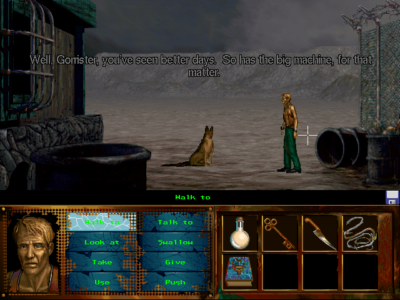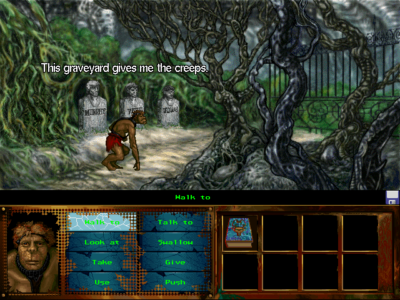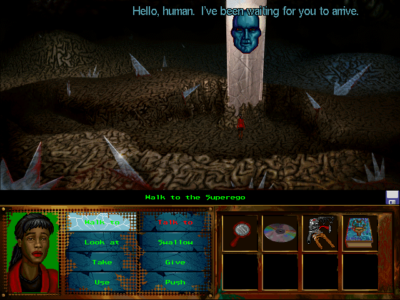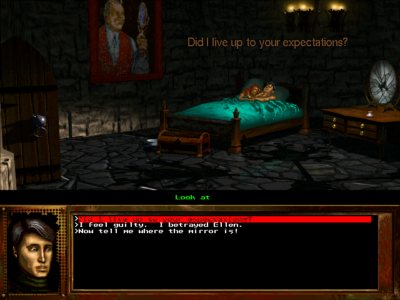
I Have No Mouth, And I Must Scream
Written by: Rik
Date posted: March 16, 2019
- Genre: Adventure
- Developed by: The Dreamers Guild
- Published by: Cyberdreams
- Year released: 1995
- Our score: 5
The serious, horror-style adventure is a reasonably prominent slice of 90s gaming that we’ve largely overlooked here on FFG, with our tendency over the years being to characterise games in the genre as falling into one of two broad categories: humorous and enjoyable LucasArts japes or daft and frustrating Sierra nonsense (ho-ho, only joking, Sierra fans. But not really). Frequently however an adventure would aim at darker and more serious territory, and we have covered one or two here, such as Creative Reality’s DreamWeb, or another Cyberdreams title, Dark Seed.
While most futuristic games are happy to settle for a dystopia of some kind with dark skies, a bit of rain and more crime, I Have No Mouth, And I Must Scream, based upon the short story by Harlan Ellison, goes for something significantly bleaker: a future where humanity has been wiped from the face of the earth entirely, victims of a war conducted by an all powerful AI, the Allied Mastercomputer (known throughout the game as AM), who leaves only an unfortunate handful of humans alive as his playthings.
An introductory voice-over reveals the extent of AM’s unhinged nature as he rants about his hatred for mankind while his human playthings writhe in agony. Our cast, who have been forced to endure this treatment for over 100 years, comprises Gorrister, a truck driver; Ellen, an electrical engineer; Benny, a military man reduced by AM to the form of an ape; Nimdok, a German doctor; and Ted, a con-artist. The physical torture inflicted upon the humans is but part of their suffering, as AM enjoys constructing quests and tasks for them to attempt and fail over and over again.And so, as AM’s rambling ceases, the player can choose a character to guide through their individual scenario. Each is designed to play upon that person’s perceived flaws and weaknesses, with numerous opportunities to do the right or wrong thing, and characters may be sent back to the start or deemed by AM, to a greater or lesser extent, to have completed their story. When all characters reach this point, there follows a final endgame, with the choices and mistakes made along the way feeding into the possible chances of success in defeating AM and getting some kind of positive ending.
It’s worth bearing in mind however that optimism is in short supply here, and apparently the stated intention of author Ellison, who collaborated with Cyberdreams on story development, was that there should be no way to ‘beat’ the game, with different levels of failure the only possible outcomes for the player. It’s therefore rather easy to muck something up in I Have No Mouth, and you are indeed permitted to head down a path of certain doom without this being signposted by the game. Such an approach is also complicated by the number of bugs and glitches experienced throughout, making it occasionally difficult to determine whether the game is broken or you’re just stuck.
One curiosity is that some inventory objects only appear in the game world when you’ve followed the right sequence of events, even if those events don’t directly or logically relate to that object appearing. (In this case you could, I suppose, make an argument that this is all part of AM’s plan to toy with the humans). At other points, there are definite bugs: characters literally not doing what you ask (I had repeated problems with Gorrister failing to pick up a shovel and instead wandering off to his death) or saying they can’t see an object that is both visibly obvious and recognised by the interface. Speaking of which, it’s a pretty clumsy system, with multiple verbs for doing similar things: sometimes they’re interchangeable, and sometimes they’re not, and sometimes none of them work, because you’re instead supposed to initiate a conversation and select the action from a list of dialogue options. Invisible exits are also a recurring annoyance, as is the need to push or use doors that are shown on screen.
If you choose to play through the characters’ stories from left to right as they stand at the select screen, then Gorrister’s will be the first you experience. Though it could be a product of getting used to the game and what it’s about, his adventure does seem to be one of the more complicated ones, and suffers more than most from some of the issues described above. The temptation to chuck it all in and do something else is tempered slightly, however, by the desire to find out some more about him and his story, and the same could be said for the game as a whole. Each character has something to confront, and it’s uncovering what this is, piece by piece, through these metaphorical stories that encourages you to look past the other annoyances. (I’ve deliberately not gone into specifics here to avoid spoilers but for a bit more on each character, see Which of you five would like to play my little game?).
I’m less convinced by I Have No Mouth as some kind of complex ethical/moral puzzler. While you definitely have the option to make dubious choices, there are few compelling reasons to do so. It’s obvious from the outset that these characters are flawed and desperately seeking salvation of some kind, so other than to satisfy some curiosity in terms of seeing the results, I’m not sure why you’d do anything that jeopardises your chances.
Often there will be an invitation to do something that is probably or definitely bad, in order to get what you want or need quickly (or so it seems). I suppose these situations do count as moral dilemmas but choosing what to do never seemed all that difficult or interesting to me. I guess you could say that many adventures don’t even give you the opportunity to do a bad thing, or block it off, whereas here you’re free to do so. Anyway, your progress in this regard is indicated by a spiritual barometer, a portrait of your character in the left hand corner of the interface, and as previously mentioned you can kibosh your chances of finishing the game by not making enough good choices.
Aesthetically, I Have No Mouth is a curious mix of the genuinely bleak and effective and the slightly laughable. Backgrounds and characters look good but the latter move in an erratic and cartoonish manner, which sort of undermines their effectiveness, while music can also be a bit more comical than atmospheric. Acting is generally ok, although only Harlan Ellison himself, as the voice of AM, is actually credited. The author is clearly having a ball, and there are moments of dark comedy, particularly during Benny’s section where AM appears as the sinister overlord of a tribal village. Speaking of Benny, he’s the only character whose voice doesn’t seem to fit his character, although Nimdok’s does stray a little too much into pantomime Ze Germanz territory at times (mind you, it doesn’t detract too much from the straight out grimness of this section). Dialogue text that obscures the heads of characters isn’t an issue unique to I Have No Mouth, but it did seem particularly clumsy here.
With all individual stories told, there’s a final section in which each character in turn can be transported into a representation of AM’s brain to try and do some damage. I have to admit at this point I wasn’t entirely clear on what was happening, and although defeating AM is mentioned at various points throughout, I had focused more on each individual scenario than anything else. Aside from a brief interlude in Ted’s story, the characters have very little interaction with each other, and the finale is the only section in which their actions have notable crossover. Provided you haven’t mucked anything up too badly by this point, there’ll be an opportunity to get any of the multiple endings, many of which will be pretty bleak. Items collected along the way, along with your spiritual barometer (which acts as kind of a health meter here) are necessary parts of the overall solution.
As I mentioned, it’s mainly those tales of failure and attempted redemption that I found to be the main draw here. And I do think that there is enough interesting about I Have No Mouth to overlook some otherwise extremely annoying flaws and idiosyncrasies and give it a few hours of your time. It’s not exactly a classic, flawed or otherwise, and I’d probably have given up pretty quickly without a walk-through back in the day (although, come to think of it, I don’t recall ever seeing this game for sale in the UK) but for the sympathetic retro-gamer wanting to look back at something a little bit unusual, it’s certainly worth investigating.






 Posts
Posts
This one’s been sitting on the pile for quite a long time. Thanks for this review, it might actually prod me to finally play it. It at least reaffirmed what interested me in the first place.
Does the game ever explain how AM is able to exert physical control over the prisoners? From what I’ve been able to piece together of the plot, it doesn’t seem like they’re in a virtual reality simulation.
March 19, 2019 @ 6:06 am
It is explained – but far enough in that to repeat it here would be spoiler territory.
The scenarios are hallucinations, I think, with the endgame taking place in a sort of cyberspace as the characters are somehow translated into digital versions of themselves.
March 19, 2019 @ 8:07 am